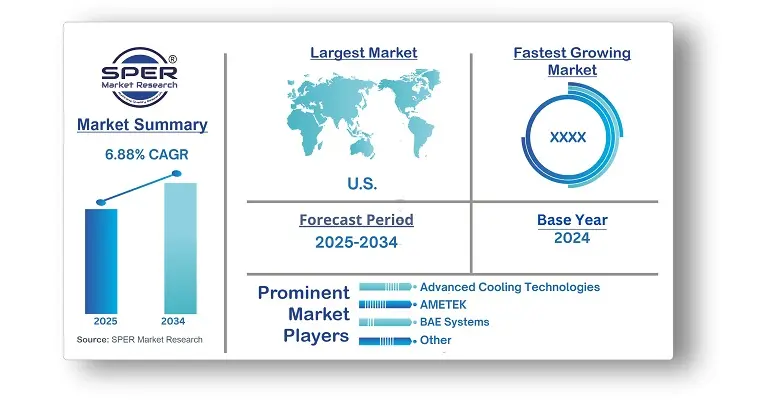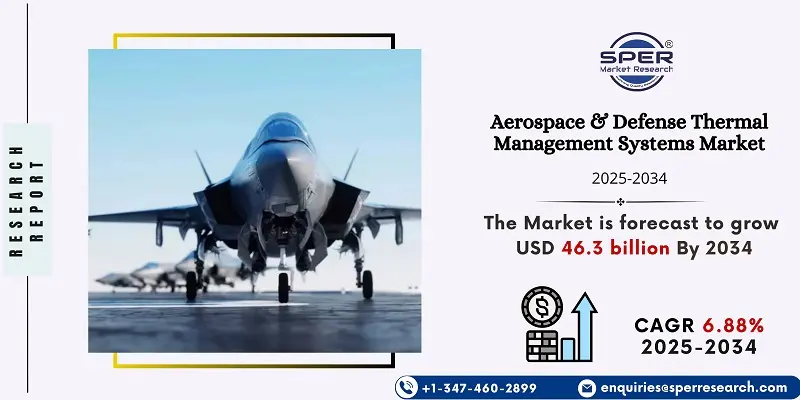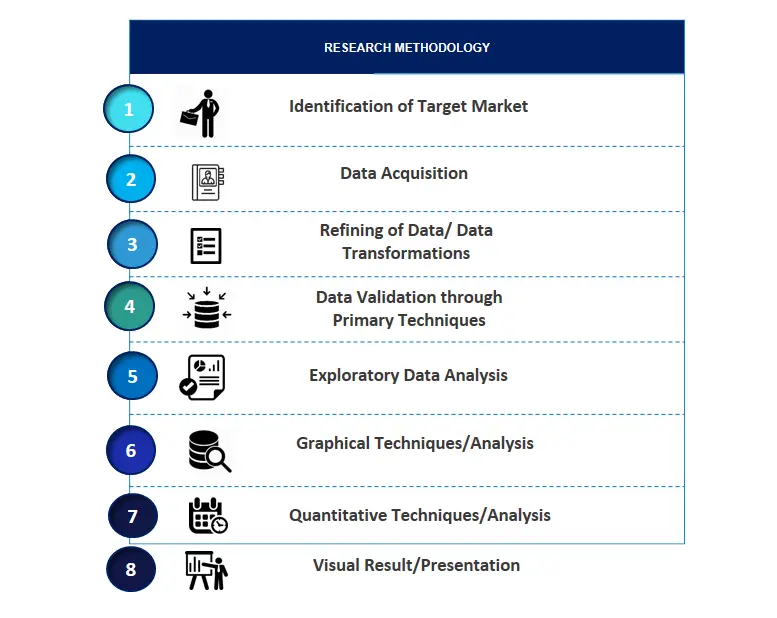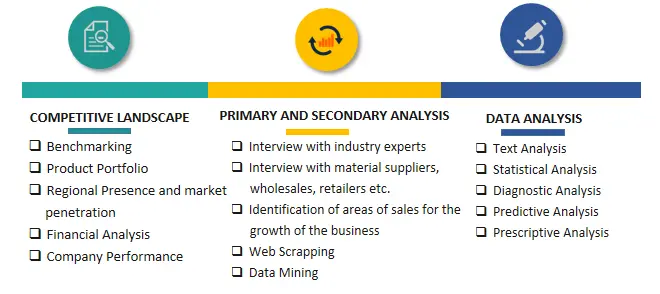
Aerospace & Defense Thermal Management Systems Market Size, Share and Outlook 2034
Aerospace & Defense Thermal Management Systems Market Growth, Size, Trends Analysis- By Platform, By System Type, By Component, and By Application- Regional Outlook, Competitive Strategies and Segment Forecast to 2034
| Published: Oct-2025 | Report ID: AERO2526 | Pages: 1 - 230 | Formats*: |
| Category : Aerospace and Defence | |||


- In February 2025, Collins Aerospace, part of RTX, successfully tested its next-generation Power and Thermal Management System (PTMS) demonstrator. The company’s Enhanced Power and Cooling System (EPACS) is designed to support future upgrades of the F-35, offering cooling performance that exceeds twice the capacity of the existing platform.
- In June 2023, Intergalactic launched the GS1-EV Eagle5, a fully integrated thermal management system tailored for eVTOL aircraft. The system cools cabins and batteries using a pumped two-phase design, providing adjustable and efficient temperature regulation. It is the first standardized thermal solution specifically developed for electric aviation platforms.
| Report Metric | Details |
| Market size available for years | 2021-2034 |
| Base year considered | 2024 |
| Forecast period | 2025-2034 |
| Segments covered | By Platform, By System Type, By Component, and By Application |
| Regions covered | North America, Latin America, Asia-Pacific, Europe, Middle East & Africa |
| Companies Covered | Advanced Cooling Technologies, AMETEK, BAE Systems, Bascom Hunter, Boyd Corporation, Collins Aerospace, Crane Aerospace and Electronics, Honeywell International, Laird Thermal Systems, Liebherr Aerospace, Marotta Controls, Meggitt |
- Global Aerospace & Defense Thermal Management Systems Market Size (FY’2021-FY’2034)
- Overview of Global Aerospace & Defense Thermal Management Systems Market
- Segmentation of Global Aerospace & Defense Thermal Management Systems Market By Platform (Aircraft, Land systems, Naval systems)
- Segmentation of Global Aerospace & Defense Thermal Management Systems Market By System Type (Active thermal management systems, Passive thermal management systems)
- Segmentation of Global Aerospace & Defense Thermal Management Systems Market By Component (Cold plates, Heat exchangers, Fans & blowers, Pumps & compressors, Valves & sensors, Thermal insulation materials, Others)
- Segmentation of Global Aerospace & Defense Thermal Management Systems Market By Application (Avionics & electronics cooling, Engine cooling, Energy storage cooling, Weapons systems cooling, Cabin comfort, Others)
- Statistical Snap of Global Aerospace & Defense Thermal Management Systems Market
- Expansion Analysis of Global Aerospace & Defense Thermal Management Systems Market
- Problems and Obstacles in Global Aerospace & Defense Thermal Management Systems Market
- Competitive Landscape in the Global Aerospace & Defense Thermal Management Systems Market
- Details on Current Investment in Global Aerospace & Defense Thermal Management Systems Market
- Competitive Analysis of Global Aerospace & Defense Thermal Management Systems Market
- Prominent Players in the Global Aerospace & Defense Thermal Management Systems Market
- SWOT Analysis of Global Aerospace & Defense Thermal Management Systems Market
- Global Aerospace & Defense Thermal Management Systems Market Future Outlook and Projections (FY’2025-FY’2034)
- Recommendations from Analyst
- 1.1. Scope of the report
- 1.2. Market segment analysis
- 2.1. Research data source
- 2.1.1. Secondary Data
- 2.1.2. Primary Data
- 2.1.3. SPERs internal database
- 2.1.4. Premium insight from KOLs
- 2.2. Market size estimation
- 2.2.1. Top-down and Bottom-up approach
- 2.3. Data triangulation
- 4.1. Driver, Restraint, Opportunity and Challenges analysis
- 4.1.1. Drivers
- 4.1.2. Restraints
- 4.1.3. Opportunities
- 4.1.4. Challenges
- 5.1. SWOT Analysis
- 5.1.1. Strengths
- 5.1.2. Weaknesses
- 5.1.3. Opportunities
- 5.1.4. Threats
- 5.2. PESTEL Analysis
- 5.2.1. Political Landscape
- 5.2.2. Economic Landscape
- 5.2.3. Social Landscape
- 5.2.4. Technological Landscape
- 5.2.5. Environmental Landscape
- 5.2.6. Legal Landscape
- 5.3. PORTERs Five Forces
- 5.3.1. Bargaining power of suppliers
- 5.3.2. Bargaining power of buyers
- 5.3.3. Threat of Substitute
- 5.3.4. Threat of new entrant
- 5.3.5. Competitive rivalry
- 5.4. Heat Map Analysis
- 6.1. Global Aerospace & Defense Thermal Management Systems Market Manufacturing Base Distribution, Sales Area, Product Type
- 6.2. Mergers & Acquisitions, Partnerships, Product Launch, and Collaboration in Global Aerospace & Defense Thermal Management Systems Market
- 7.1. Aircraft
- 7.2. Land systems
- 7.3. Naval systems
- 8.1. Active thermal management systems
- 8.2. Passive thermal management systems
- 9.1. Cold plates
- 9.2. Heat exchangers
- 9.3. Fans & blowers
- 9.4. Pumps & compressors
- 9.5. Valves & sensors
- 9.6. Thermal insulation materials
- 9.7. Others
- 10.1. Avionics & electronics cooling
- 10.2. Engine cooling
- 10.3. Energy storage cooling
- 10.4. Weapons systems cooling
- 10.5. Cabin comfort
- 10.6. Others
- 11.1. Global Aerospace & Defense Thermal Management Systems Market Size and Market Share
- 12.1. Asia-Pacific
- 12.1.1. Australia
- 12.1.2. China
- 12.1.3. India
- 12.1.4. Japan
- 12.1.5.South Korea
- 12.1.6. Rest of Asia-Pacific
- 12.2. Europe
- 12.2.1. France
- 12.2.2. Germany
- 12.2.3. Italy
- 12.2.4. Spain
- 12.2.5. United Kingdom
- 12.2.6. Rest of Europe
- 12.3. Middle East and Africa
- 12.3.1. Kingdom of Saudi Arabia
- 12.3.2. United Arab Emirates
- 12.3.3. Qatar
- 12.3.4.South Africa
- 12.3.5. Egypt
- 12.3.6. Morocco
- 12.3.7. Nigeria
- 12.3.8. Rest of Middle-East and Africa
- 12.4. North America
- 12.4.1. Canada
- 12.4.2. Mexico
- 12.4.3. United States
- 12.5. Latin America
- 12.5.1. Argentina
- 12.5.2. Brazil
- 12.5.3. Rest of Latin America
- 13.1. Advanced Cooling Technologies
- 13.1.1. Company details
- 13.1.2. Financial outlook
- 13.1.3. Product summary
- 13.1.4. Recent developments
- 13.2. AMETEK
- 13.2.1. Company details
- 13.2.2. Financial outlook
- 13.2.3. Product summary
- 13.2.4. Recent developments
- 13.3. BAE Systems
- 13.3.1. Company details
- 13.3.2. Financial outlook
- 13.3.3. Product summary
- 13.3.4. Recent developments
- 13.4. Bascom Hunter
- 13.4.1. Company details
- 13.4.2. Financial outlook
- 13.4.3. Product summary
- 13.4.4. Recent developments
- 13.5. Boyd Corporation
- 13.5.1. Company details
- 13.5.2. Financial outlook
- 13.5.3. Product summary
- 13.5.4. Recent developments
- 13.6. Collins Aerospace
- 13.6.1. Company details
- 13.6.2. Financial outlook
- 13.6.3. Product summary
- 13.6.4. Recent developments
- 13.7. Crane Aerospace and Electronics
- 13.7.1. Company details
- 13.7.2. Financial outlook
- 13.7.3. Product summary
- 13.7.4. Recent developments
- 13.8. Honeywell International
- 13.8.1. Company details
- 13.8.2. Financial outlook
- 13.8.3. Product summary
- 13.8.4. Recent developments
- 13.9. Laird Thermal Systems
- 13.9.1. Company details
- 13.9.2. Financial outlook
- 13.9.3. Product summary
- 13.9.4. Recent developments
- 13.10. Liebherr Aerospace
- 13.10.1. Company details
- 13.10.2. Financial outlook
- 13.10.3. Product summary
- 13.10.4. Recent developments
- 13.11. Others
SPER Market Research’s methodology uses great emphasis on primary research to ensure that the market intelligence insights are up to date, reliable and accurate. Primary interviews are done with players involved in each phase of a supply chain to analyze the market forecasting. The secondary research method is used to help you fully understand how the future markets and the spending patterns look likes.
The report is based on in-depth qualitative and quantitative analysis of the Product Market. The quantitative analysis involves the application of various projection and sampling techniques. The qualitative analysis involves primary interviews, surveys, and vendor briefings. The data gathered as a result of these processes are validated through experts opinion. Our research methodology entails an ideal mixture of primary and secondary initiatives.



Frequently Asked Questions About This Report
PLACE AN ORDER
Year End Discount
Sample Report
Pre-Purchase Inquiry
NEED CUSTOMIZATION?
Request CustomizationCALL OR EMAIL US
100% Secure Payment






Related Reports
Our Global Clients
Our data-driven insights have influenced the strategy of 200+ reputed companies across the globe.






















